
History of the Lincoln Cent
1907 Brenner Lincoln Plaque
This was the model for the 1909 Lincoln cent designed by Victor D. Brenner.
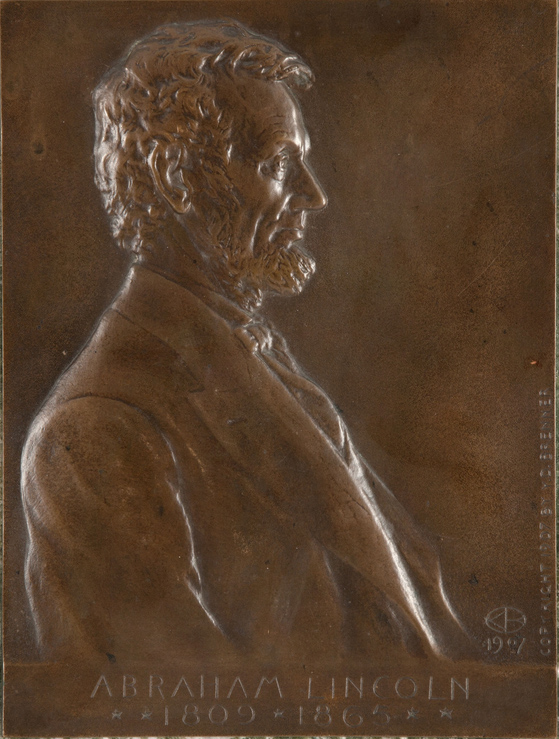
Photo By Heritage Auctions
The first Lincoln cent was produced in 1909, the 100th anniversary of Lincoln's birth. It was a new style for US coins, the first time a portrait was used in the regular the series. The new Lincoln cent was designed by Victor David Brenner after a plaque he had executed earlier. It was also the first time the motto "In God We Trust" appeared on a US cent. For the reverse of the coin, two wheat heads in memorial style with the denomination and the words "UNITED STATES OF AMERICA" between them was chosen from three different designs. At the top, the words "E PLURIBUS UNUM" which means "One out of Many".
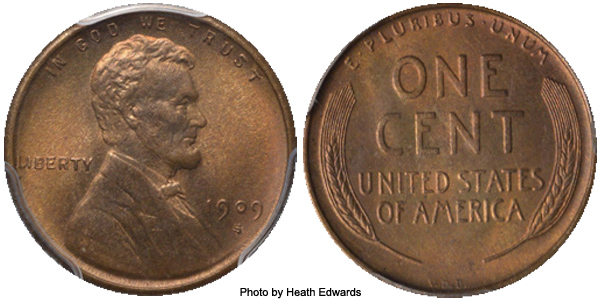
The new coin was released to the public on August2, 1909. The first of the Lincoln cents issued had the designer's initials at the bottom of the reverse "VDB". Many people protested the initials saying that they distracted from the design, so the initials were removed completely. They were added back to the coin in 1918, but this time on the obverse side and very small, just under the shoulder of Lincoln.


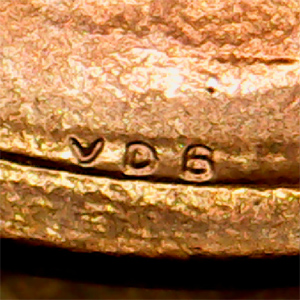
Have you ever wondered why the portrait of Lincoln faces to the right while all other presidents on coins face to the left? Well, no particular reason, it just happened that way. The plaque by Victor David Brenner in which the cent was modeled after was that way. The Lincoln cent is the only coin currently in circulation, where the portrait faces to the right.

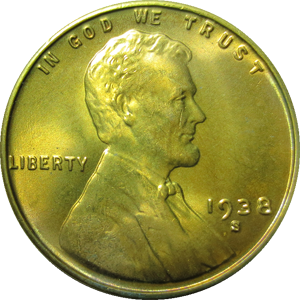
The composition of the Lincoln cent was 95% Copper and 5% Zinc. During world war two, these metal were not available to the mint, so they had to search for a substitute. Zinc coated steel was chosen. Starting on February 27, 1943, a low-grade Carbon Steel was used as the base of the coin, coated with a .005 inch thick Zinc coating to prevent rust. By the end of 1943, the three mints combined produced 1.093,838,670 of the new Zinc coated Steel coins. On January 01, 1944, the mint changed the composition again by using spent shell casings from the war, this continued until 1946. From 1946 until 1962, the composition was 95% Copper and 5% Tin & Zinc. The cents minted between 1943 and 1945 are known as War Time Cents.
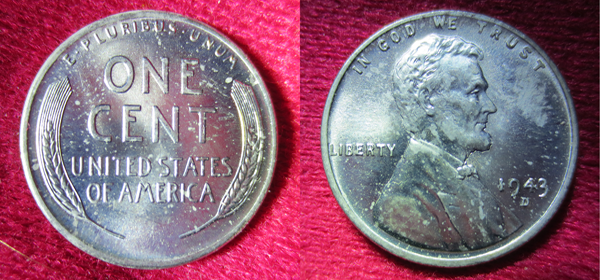
The total mintage of all the Lincoln wheat reverse design coins is over 25 billion coins.
Lincoln Memorial Reverse
On the 150th anniversary of Lincoln's birth, in February of 1959, a new reverse design was introduced. Assistant Engraver at the Philadelphia Mint, Frank Gasparro, designed the new reverse. This time, of the Lincoln memorial. The initials "FG" appear very small to the right of the memorial.
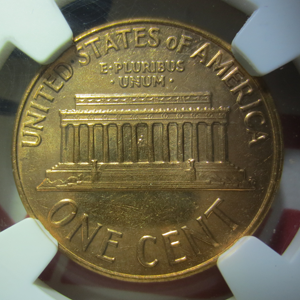
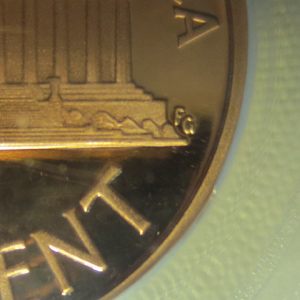
In 1962, the composition of the coin changed again by losing the Tin content and returning to the 95% Copper and 5% Zinc alloy. Then in 1982 the composition changed again. This time to Copper-plated Zinc. This composition, which is still in use today, is 97.5% Zinc and 2.5% Copper and today's Lincoln cent weighs 2.5 grams.
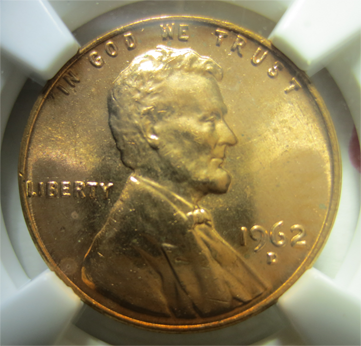
In 2009, the 200th anniversary of Lincoln's birth, the reverse of the coin changed again. 2009 saw four different reverse designs: Professional Life, Birth and Early Childhood, Presidency, and Formative Years. 2009 also saw the first Copper coins minted since 1982. They weren't issued for general circulation, only in the government issued mint and proof sets.
Including Proofs, there were 20 different varieties of Lincoln cent minted in 2009. To learn more about the 2009 cents click here.

Union Shield Reverse
In 2010 a new reverse designed by Lyndall Bass depicting a Union shield was used and it still in use today.
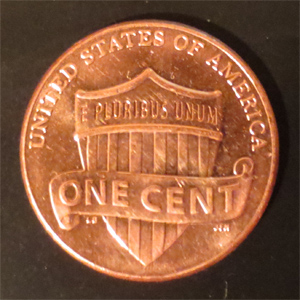
Out of eighteen finalists in a Federal competition, Lyndall Bass’ design was selected. The intitials LB can be seen to the left of the shield just under the scroll. The initials on the other side of the shield stand for Joseph F. Mennna who sculpted the design.
The stripes on the shield symbolize the original 13 colonies joined together in one union. There is a scroll across the shield withe the inscription "ONE CENT". The new design has much less detail than the Lincoln Memorial reverse that it replaced.
Weight 2.5 g Diameter 19.05 mm Thickness 1.52 mm Composition Copper-plated Zinc (97.5% Zinc, 2.5% Copper)
Proof verses Business Strike
There are two distinct types of Lincoln cents minted, the Proof type minted for collectors and the Business strike minted for general circulation.
Proof coins are minted with highly polished dies and struck multiple times to give a highly detailed and shiny, mirror like finish to the coin's surface. They will also have sharper rims than business strikes.
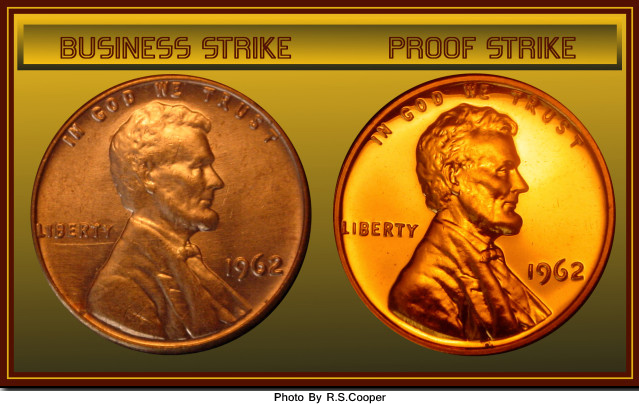
There were no mint marks on Proof cents minted from 1909 - 1964, after that, they have an S mint mark from San Francisco.
1984-S Proof Strike
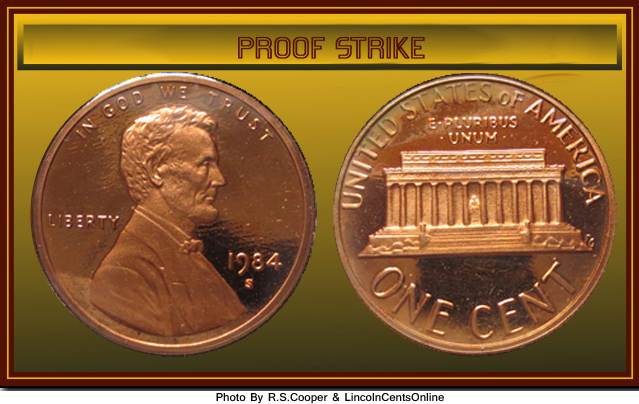
The San Francisco mint also produced some business strikes that carried the S mint mark, but the last time this happened was in 1974.
1974-S Business Strike
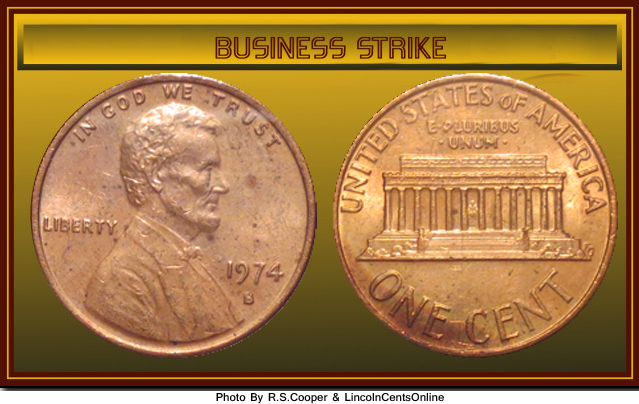
Mint Marks
Mint marks are the letters located just under the date of Lincoln cents. There have been many different style mint marks over the years, but the letters have all represented the same mints. The "S" mint mark is for cents minted in San Francisco California, the "D" mint mark represents the Denver mint in Colorado, and cents without a mint mark are minted in Philadelphia Pennsylvania.

There have been cents minted at the West Point mint, but not on a regular basis and these cents also had no mint mark.
In 2017, the 225th anniversary of the mint in Philadelphia, the mint issued cents bearing the "P" mint mark for the first time in it's history. The cents with the "P" mint mark are included in collector mint sets as well as business strikes issued for general circulation.
The first time a "P" mint mark was ever used on a US coin was during World War II in 1942 on the Silver "war time" Jefferson Nickels.
The use of the "P" mint mark on cents is to be for one year only on the 2017 cents.
Next Section